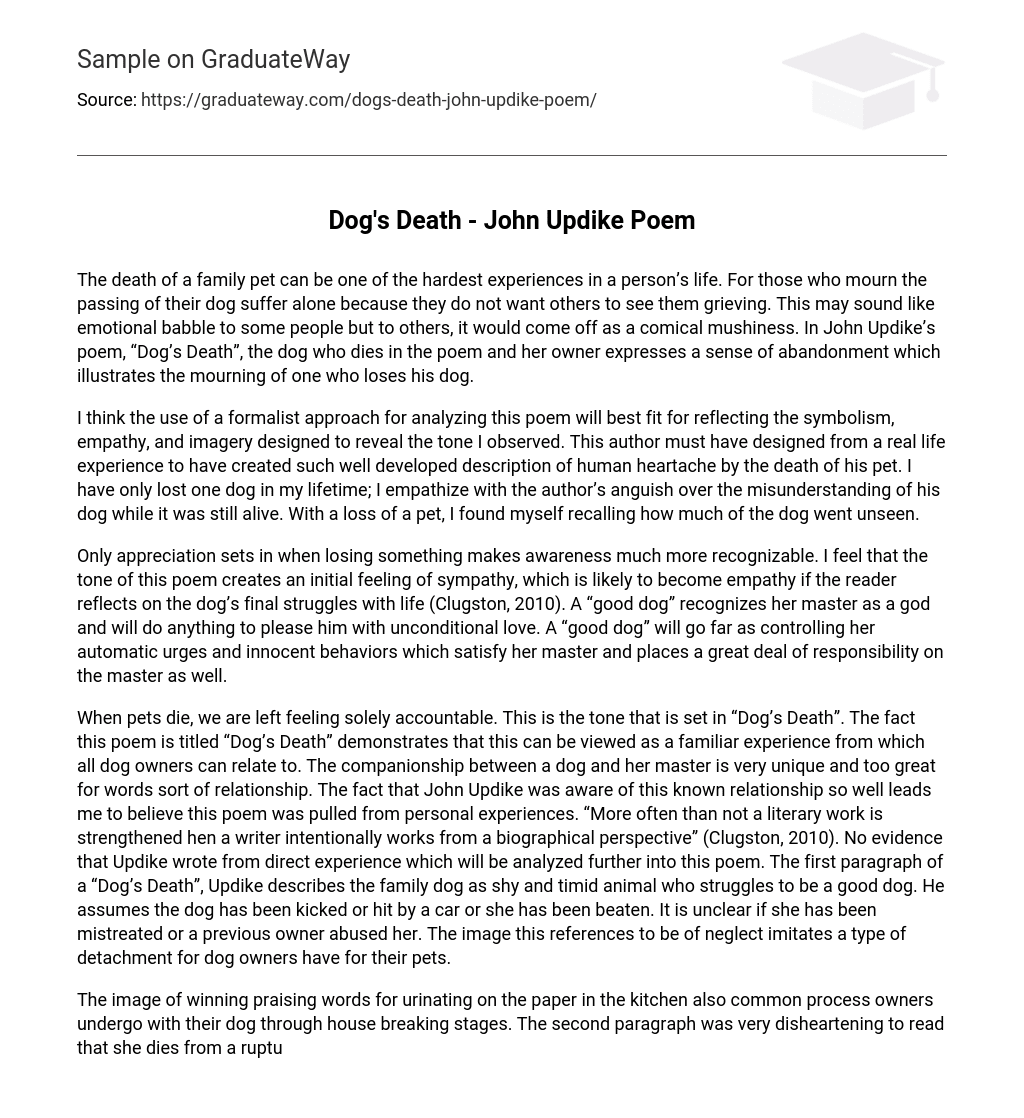The death of a family pet can be one of the hardest experiences in a person’s life. For those who mourn the passing of their dog suffer alone because they do not want others to see them grieving. This may sound like emotional babble to some people but to others, it would come off as a comical mushiness. In John Updike’s poem, “Dog’s Death”, the dog who dies in the poem and her owner expresses a sense of abandonment which illustrates the mourning of one who loses his dog.
I think the use of a formalist approach for analyzing this poem will best fit for reflecting the symbolism, empathy, and imagery designed to reveal the tone I observed. This author must have designed from a real life experience to have created such well developed description of human heartache by the death of his pet. I have only lost one dog in my lifetime; I empathize with the author’s anguish over the misunderstanding of his dog while it was still alive. With a loss of a pet, I found myself recalling how much of the dog went unseen.
Only appreciation sets in when losing something makes awareness much more recognizable. I feel that the tone of this poem creates an initial feeling of sympathy, which is likely to become empathy if the reader reflects on the dog’s final struggles with life (Clugston, 2010). A “good dog” recognizes her master as a god and will do anything to please him with unconditional love. A “good dog” will go far as controlling her automatic urges and innocent behaviors which satisfy her master and places a great deal of responsibility on the master as well.
When pets die, we are left feeling solely accountable. This is the tone that is set in “Dog’s Death”. The fact this poem is titled “Dog’s Death” demonstrates that this can be viewed as a familiar experience from which all dog owners can relate to. The companionship between a dog and her master is very unique and too great for words sort of relationship. The fact that John Updike was aware of this known relationship so well leads me to believe this poem was pulled from personal experiences. “More often than not a literary work is strengthened hen a writer intentionally works from a biographical perspective” (Clugston, 2010). No evidence that Updike wrote from direct experience which will be analyzed further into this poem. The first paragraph of a “Dog’s Death”, Updike describes the family dog as shy and timid animal who struggles to be a good dog. He assumes the dog has been kicked or hit by a car or she has been beaten. It is unclear if she has been mistreated or a previous owner abused her. The image this references to be of neglect imitates a type of detachment for dog owners have for their pets.
The image of winning praising words for urinating on the paper in the kitchen also common process owners undergo with their dog through house breaking stages. The second paragraph was very disheartening to read that she dies from a ruptured liver and this sheds light on the puppy’s personality. Recognize how he is not aware of her painful suffering until it is too late and she is dead. This is a common type of remorse pet owners face during the first stages of grieving. Often times, owners think of “If I only I would have done this or that…” is a typical reaction after a loss of a pet.
The saddest part of reading further into this poem is the entire time the dog was playing with the family; she was enduring secret pain that no one knew about because she could not communicate with anyone (Clugston, 2010). Towards the end of the poem the children are sent to school Monday morning as the dog crawled beneath the youngest bed. Recognizing the image of her clinging to life of the children while they were home shows her to be strong willed. I gathered a “good dog” respects and enjoys the company of her family and hides the pain to protect her loved ones from suffering beside her.
This dog definitely shows joy by human companionship. In the final moments of her life she bit her owner but why? Perhaps it was out of fear of losing that touch and reaching out to her owner for reaction. Or, maybe she was upset from her owner stroking her fur. I imagine that Updike flinch his hand from her mouth and shaming her. Punishment for a dog is shame in itself but perhaps this was enough to break her spirit and cause instant death. With the yelling of the wife for the love to keep the dog from letting go life, it was no use for she had already died. Therefore, Updike says that she endured shame from missing the paper.
He never did mention that she endured pain. I feel shame is worse than pain for a “good dog”. John Updike’s effective use of imagery, empathy, symbolism, and tone really spoke to me because I could relate to the experience since I too have had a “good dog” that died. Updike gracefully illustrated one of the saddest moments in my life. Losing a dog made me feel like I was suffering alone in their last hours on earth. Also, I learned an important lesson from this poem; there is no shame in death for one who has a strong spirit. I will make sure the last moments of my loved ones life are happy times with laughter and love.





